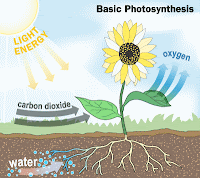
See if you can explain a science concept by following these steps:
1. Read the paragraph below.
2. Write the title.
3. Write the words you do not know. Look up the meaning and write the meaning.
4. Draw a picture or diagram for each sentence. Write a phrase for each picture.
5. Practice saying or explaining the first half of the diagram you drew.
6. Practice saying or explaining the last half of the diagram you drew.
7. Practice saying or explaining all of the diagram you drew.
8. Have another person read the paragraph to you (or use a tape recorder), as you write it.
9. Write the paragraph without looking at the paper.
The Water Cycle
The water cycle, or the hydrologic cycle, is the repeated movement of water through the environment in different forms. The steps of the water cycle include evaporation, condensation, and precipitation. Evaporation is the changing of liquid water to water vapor. Liquid water evaporates into invisible water vapor when it is heated by the sun. In condensation, air cools and some of the water vapor turns into a liquid, such as water droplets in clouds or fog. These water droplets are so small they remain suspended in air. In precipitation, air cools further so the water droplets grow large enough to fall from clouds as rain, hail, sleet, or snow.
2. Write the title.
3. Write the words you do not know. Look up the meaning and write the meaning.
4. Draw a picture or diagram for each sentence. Write a phrase for each picture.
5. Practice saying or explaining the first half of the diagram you drew.
6. Practice saying or explaining the last half of the diagram you drew.
7. Practice saying or explaining all of the diagram you drew.
8. Have another person read the paragraph to you (or use a tape recorder), as you write it.
9. Write the paragraph without looking at the paper.
The Water Cycle
The water cycle, or the hydrologic cycle, is the repeated movement of water through the environment in different forms. The steps of the water cycle include evaporation, condensation, and precipitation. Evaporation is the changing of liquid water to water vapor. Liquid water evaporates into invisible water vapor when it is heated by the sun. In condensation, air cools and some of the water vapor turns into a liquid, such as water droplets in clouds or fog. These water droplets are so small they remain suspended in air. In precipitation, air cools further so the water droplets grow large enough to fall from clouds as rain, hail, sleet, or snow.
Photosynthesis
Plants make food through a process called photosynthesis. The roots absorb nutrients and water. It travels through tubes called xylem. The xylem tube takes water and nutrients to the leaves. With the help of the sun and chlorophyll, water and carbon dioxide are changed into glucose. The phloem tube takes the sugar, or glucose, back to the rest of the plant. When we breathe out, we release carbon dioxide that helps the plants with photosynthesis. It takes six molecules of water and six molecules of carbon dioxide to make just one molecule of sugar. Here is a way to remember photosynthesis; photo means light, and synthesis means combination.
